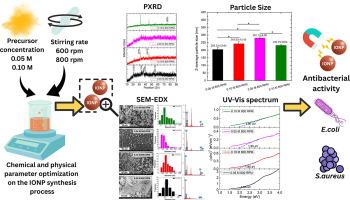Characterization and antibacterial activity of iron oxide nanoparticles synthesized using co-precipitation method
IF 4.3
Q2 CHEMISTRY, PHYSICAL
引用次数: 0
Abstract
Iron oxide nanoparticles (IONP) could generate reactive oxygen species (ROS), which support their application for antibacterial purposes. Optimization of the IONP synthesis parameters, such as precursor concentration and stirring rate, is necessary to achieve satisfactory physicochemical properties. This study aims to evaluate the effect of precursor concentrations (0.05 M and 0.10 M) and stirring rates (600 rpm and 800 rpm) on the physicochemical characteristics and antibacterial activity of IONP. The XRD analysis confirmed the presence of the maghemite (ɣ-Fe2O3) phase. The synthesized IONP exhibited a cubic and uneven spherical shape with a band gap energy ranging from 1.83 to 1.97 eV. The hydrodynamic particle size ranged from 205 to 368 nm and exhibited a mid-range polydispersity (PDI = 0.3294-0.5991). The zeta potential values were between (-) 34.44 mV and (-) 41.74 mV, implying moderate stability and low aggregation tendency. The increase in precursor concentration reduced the crystallite size and lattice constant; however, micro-strain, crystalline index, and particle size increased. Meanwhile, the stirring rate highly affected morphology, polydispersity index (PDI), and band gap energy. The IONP with 1000 ppm concentration effectively inhibited the growth of bacteria, as confirmed by the zone of inhibition diameter, which was 9.00-17.67 mm for Escherichia coli and 10.67-14.67 mm for Staphylococcus aureus. The application of the magnetic field was also beneficial in enhancing the antibacterial activity of IONP. This study indicates that the precursor concentration and stirring rate must be rigorously controlled to obtain the required characteristics of IONP and its antibacterial activity for infectious diseases.

共沉淀法合成氧化铁纳米颗粒的表征及其抗菌活性
氧化铁纳米颗粒(IONP)可以产生活性氧(ROS),这支持了它们在抗菌方面的应用。为了获得满意的物理化学性能,需要对前驱体浓度和搅拌速率等合成参数进行优化。本研究旨在评价前驱体浓度(0.05 M和0.10 M)和搅拌速率(600 rpm和800 rpm)对IONP理化特性和抗菌活性的影响。XRD分析证实了磁赤铁矿(α -Fe2O3)相的存在。合成的离子p呈不规则的立方球形,带隙能量在1.83 ~ 1.97 eV之间。水动力粒径范围为205 ~ 368 nm,呈中等多分散性(PDI = 0.3294 ~ 0.5991)。zeta电位值介于(-)34.44 mV和(-)41.74 mV之间,稳定性中等,聚集倾向较低。前驱体浓度的增加使晶体尺寸减小,晶格常数减小;微应变、结晶指数、晶粒尺寸增大。同时,搅拌速率对形貌、多分散性指数(PDI)和带隙能有较大影响。1000 ppm浓度的离子离子p对细菌的生长有明显的抑制作用,对大肠杆菌和金黄色葡萄球菌的抑制区直径分别为9.00 ~ 17.67 mm和10.67 ~ 14.67 mm。磁场的作用也有利于提高IONP的抗菌活性。本研究表明,必须严格控制前体浓度和搅拌速度,才能获得IONP所需的特性及其对传染病的抗菌活性。
本文章由计算机程序翻译,如有差异,请以英文原文为准。
求助全文
约1分钟内获得全文
求助全文
来源期刊

Chemical Physics Impact
Materials Science-Materials Science (miscellaneous)
CiteScore
2.60
自引率
0.00%
发文量
65
审稿时长
46 days
 求助内容:
求助内容: 应助结果提醒方式:
应助结果提醒方式:


